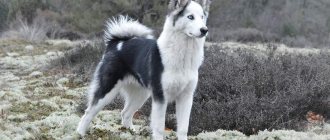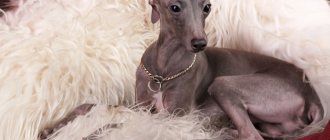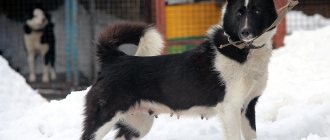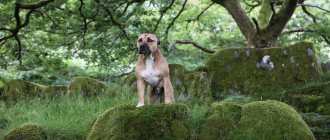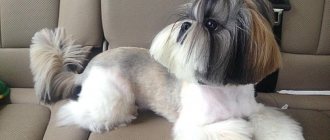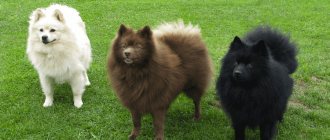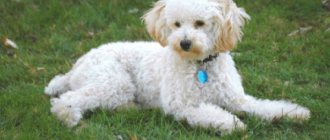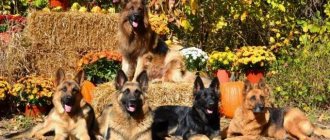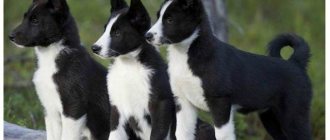| Origin | Soviet Union (Russia) |
| Usage | Hunting, sled riding |
| Color | Caramel (black and tan), pure black, white, black and white, gray, brown, red. Spots of all these colors are allowed. |
| Dimensions | Height 57-65 cm. Weight 16-23 kg. |
| Lifespan | 11-13 years old |
The East Siberian Laika is the largest of all Russian Laikas. This is a born hunter, capable of making independent decisions. Unique working qualities combine the characteristics of other hunting breeds: greyhounds, burrows, hounds. The Far Eastern Siberian Laika when hunting is a universal working dog that can find, drive out, track an animal, pick up game and bring it to it. If the size of the hole allows it, the dog will go after the prey without hesitation.
Breed standard
The first description of the standard was compiled in 1949, and amendments were made in 1981. It has been preserved in this form and is in operation today.
The East Siberian Laika has the largest number of colors among its relatives approved by the FCI standard.
The table shows the main characteristics of the breed.
| Become | Description |
| Head | Wedge shaped. The skull is wide, the back of the head is rounded. Cheekbones are not clearly defined. |
| Muzzle | The size of the muzzle is equal to the length of the head. |
| Neck | Strong, muscular. |
| Ears | Triangular in shape, high standing, with dense cartilage. The inside is covered with soft fluffy wool. |
| Eyes | Almond shaped. Slant eyelid incision. The eyeball is neither bulging nor sunken. The iris is dark brown. |
| Nose | The nasal planum has rich black pigmentation. If the coat color is light, brown earlobes are acceptable. |
| Lips | Fit tightly. |
| Bite | Scissor-shaped, with a complete set of teeth. |
| Frame | The back is wide, powerful, muscular. The loin is short, slightly convex. The croup is wide and sloping. The chest is oval-shaped, wide. The abdomen is tucked in, the transition from the chest is weakly expressed. |
| Tail | Wrapped in a ring. The length of the tail should reach the hock joint. Covered with thick, coarse hair. |
| Limbs | Forequarters: slightly sloping, muscular, strong. Located parallel to each other. Rear: straight and parallel. Developed muscles. Clearly defined articulation angle when viewed from the side. |
| Paws | Oval shape. The fingers are pressed tightly against each other. |
| Wool | Consists of two layers: soft undercoat and hard guard hair. The head and limbs are covered with short hair. The neck, withers and shoulders have a longer coat and form a collar. |
| Movements | Working run: gallop or gait. |
The Eastern Laika is subject to rejection if the following disqualifying characteristics are present:
- Insufficient pigment of the nose and eyelids.
- Smoothed withers.
- A depressed back or a curved back.
- The tail has two ring curls or is saber-shaped.
- Undershot or overshot.
- Protruding or sunken eyes.
- Rounded ear tips, drooping ears, lack of fluff on the inner surface.
- Excessive aggression, cowardice.
- Castrated males, cryptorchidism.
- Long neck.
- Pointed muzzle.
Character
East Siberian Laikas are a model of independence. They are easy to train, but at the same time they reserve the decisions for themselves. An easy-going character borders on stubbornness. It is impossible to force a dog to do something; you need to be able to negotiate. A Laika on a hunt is not a servant, but an equal partner.
It is within the power of the owner to build friendly, equal relationships with the pet. The dog willingly makes contact with people, but does not feel much love for strangers. Vigilance, endurance, and mobility are characteristic of this breed.
Character and behavior
Despite its northern origin, the animal easily adapts to other conditions and can work in almost any climate. The dog has a keen sense of smell, excellent eyesight and an innate hunter instinct. The character of the East Siberian Laika is distinguished by its independence: it is able to objectively assess current events and make the right decisions without the owner’s command.
On a note. The East Siberian Laika can hunt squirrel, sable, deer, elk, lynx and bear. Endurance and maneuverability allow the animal to be used as a sled dog.
East Siberian Laikas get along well with children, making them excellent family friends. They exhibit a hunting instinct towards other domestic animals. In rare cases, pets who grew up together find a common language.
Application
Laikas were bred as hunting helpers and for use as sled dogs.
Unlike its relatives, the West Siberian Laika and the Karelian Bear Laika, the Eastern Laika matures late. The dog is ready for a full hunt when it is closer to two years of age. Going out hunting with a husky is a pleasure for both the owner and the pet. The peculiarity of this breed is its selective pursuit of prey.
The East Siberian Laika, trained for a certain type of game, pursues only that. It is rare for a dog to be distracted by another animal.
Origin story
The East Siberian Laika is a representative of northern Russian dogs. The first mentions date back to the mid-19th century. At that time, immigrants from the European part of Russian lands went to develop Siberian and Far Eastern territories. The goal of breeding is a perfect working dog, capable of hunting large animals.
You can come across the name Evenki Laika or Evenki. There is no description of it in the specialized literature, but it is believed that the East Siberian Laika is a subtype of the Evenk Laika.
What is the difference between the East Siberian Laika and the West Siberian Laika?
For many ignorant people in this matter, the main guideline is the color, by which it is easiest to recognize the breed.
The East Siberian Laika is characterized by a black and tan or solid black color, while the West Siberian Laika standard considers this color to be a serious fault. At the same time, in both breed groups there are representatives of red and brown colors, how can they be distinguished from each other? “Easterners” are somewhat larger and more powerful in constitution, have a coarser body and muzzle structure, and a stretched body compared to “Westerners.” The breeds also differ in the shape of the ears: for “Easterns” slightly rounded ends are acceptable, for Westerners they are always only sharp, for “Easterns” they are set at eye level, and for “Westerners” they are set higher. You can also find a number of other breed differences, but only real experts can notice them. Fans of these breeds also note that East Siberian Laikas have a more trusting look, while their Western counterparts have a more lively and cunning look.
If we talk about character, then Western Siberian Laikas by nature are more striving for leadership, including over a person, which was not noticed among the Easterners.
Nansen Fridtjof, a Norwegian explorer, purchased 26 East Siberian Laikas for his Arctic expedition in 1893-1896.
Socialization
Early socialization will allow you to raise a friendly and obedient dog. From an early age, it is necessary to take the puppy in your arms and pet it so that it quickly gets used to people. In a family circle, the dog is capable of becoming a loyal friend and companion; he is wary of strangers.
Pets are perceived as prey. Therefore, it is undesirable to keep cats and birds in the same area. Laika is aggressive towards other dogs. She has a great instinct to protect her territory.
Little children make huskies want to play. You cannot leave an animal alone with a child. The dog, without meaning to, can scare the baby. At the same time, a pet can become a good and caring friend.
How to choose a puppy
When choosing a baby, pay attention to his physical condition and temperament. The East Siberian husky puppy is curious and brave, without showing anger or aggression. He is interested in everything and is always ready to explore new objects. During feeding, a strong puppy strives to reach the rear nipples of the bitch, while pushing away its weaker brothers and sisters. A healthy puppy is constantly in search of food.
The fur of a small husky is shiny, smooth, without bald spots. The baby's tail should be curled into a ring. By the color of the nails, hunters can predict the puppy's purpose. It is believed that dark claws indicate a predisposition to hunting large animals, and light claws indicate a predisposition to hunt small game.
When looking for a future hunting partner, you need to study the pedigree. It’s good if it is possible to trace ancestors back to the fifth generation: working qualities are inherited.
Where can I buy an East Siberian Laika?
In order not to end up with a mixed breed, but to purchase a purebred breed, you need to use the services of proven nurseries with a good reputation.
The price of an East Siberian Laika depends on the achievements of the puppy's parents. If they are able to drive down a large animal, then their puppies are usually more expensive.
A potential buyer is recommended to prepare at least twenty thousand rubles; prices for mestizos are more affordable and can fluctuate in the amount of five thousand rubles.
How to choose an East Siberian husky puppy
Choosing an East Siberian husky puppy should start with choosing its parents . Decide what you want to get from your dog. If you are an avid hunter, then you need to look for a litter born from two working dogs.
For exhibitions, you can purchase a puppy with good external characteristics, but we note that in this case it is better for you to take a teenage puppy, when it is already clear whether he will be promising at exhibitions. In general, it is possible to take a baby away from its mother and bring it to a new home at the age of 1.5-2 months.
It is also important to decide on the gender of the future puppy - males can be used for hunting all year round, but females can only be used when they are not in heat.
Price
The price of an East Siberian husky puppy varies greatly depending on geography, the merits of the parents and many other factors. In nurseries, puppies usually cost 25,000-35,000 rubles. For private breeders, 5,000-15,000 rubles. An adult working husky can cost 60,000 rubles. and more expensive.
Features of maintenance and care
The East Siberian Laika is a freedom-loving and physically active animal. Living freely in the city is not possible. The special constitution of the body requires an active lifestyle, so the best place for it is the countryside. The dog is kept on a leash. An irrepressible hunting passion drives the dog in search of adventure. A husky that finds itself free can attack neighboring animals and birds.
Grooming
Caring for a husky's fur is not difficult. Does not require frequent bathing. Periodically, you can wipe the wool with a cloth moistened with a weak aqueous solution of vinegar. During the period of seasonal molting, the dog actively loses hair. Frequent brushing will help speed up this process.
Dental care includes weekly examinations for the presence of tartar. If necessary, soft plaque is removed using a damp gauze swab.
The claws of working huskies do not require grooming or trimming; they wear down naturally. Dogs living in urban areas have their nails trimmed as they grow.
Walk
Oriental huskies require long walks. If there is not enough walks, the dog may begin to damage property and destroy the apartment. Therefore, keeping in rural areas, with a large local area, will be an ideal place for keeping.
Feeding
Laika is an unpretentious dog. She accepts dry food well. But experienced hunters believe that this breed needs only natural food.
East Siberian husky puppies are sent to new owners at the age of about one and a half to two months. By this time, he can already take food such as oatmeal cooked in meat and bone broth.
After 2 months, puppies can be given natural food. Salted and smoked foods are prohibited. To strengthen bones, add half a teaspoon of finely crushed egg shells to your food daily. At this age, the puppy begins to receive finely chopped raw meat.
It is necessary to teach your dog to eat raw vegetables and fruits: beets, carrots, tomatoes, apples. They are necessary for normal digestion and also contribute to the natural cleaning of teeth. To strengthen its teeth, the East Siberian husky is regularly given large raw bones and tendons to chew on.
At 2 months of age, the number of feedings is 5-6 times a day. By 8-10 months of age, the dog is fed twice a day, the diet is the same as that of an adult. Many breeders note that Siberian huskies regulate the amount of food they eat.
A working dog that regularly goes hunting has a better appetite than a city apartment pet. The greater the energy expenditure, the more the dog requires food.
The table shows a list of recommended and prohibited products.
| Allowed | Prohibited |
| Lean meat (raw and boiled) | Pickles |
| Lean fish (boiled) | Spicy dishes |
| Fermented milk products (up to six months) | Tubular bird bones |
| Vegetables and fruits | Smoked products |
| Cereals | Sweet pastries |
| Vegetable oil | |
| Eggs |
Health
East Siberian huskies are distinguished by good health. The average life expectancy is 10-12 years, but there have been cases of longevity. Many dogs, with proper care and proper exercise, can live 14-15 years, remaining in excellent working shape.
Diseases
Laikas are not susceptible to genetic pathologies. But they are characterized by diseases associated with hunting activities:
- Leptospirosis. While walking or while hunting, a dog can eat a mouse and become infected with this disease. Or be bitten by a marten or weasel, which can also cause infection.
- Esophageal worms. While hunting, the East Siberian husky can catch and swallow a small rodent suffering from this infection. And thus she becomes infected.
- Snake bites. The viper is the enemy of huskies. Often the dog strives to enter into a fight with a dangerous opponent. A snake bite to the neck area is especially dangerous. The owner must have anti-snake serum with him. This will help save your pet from death.
Vaccinations
A healthy dog is the owner's concern. Carrying out routine mandatory vaccinations will protect your pet from dangerous fatal diseases, one of which is rabies. Owners of huskies are advised not to miss vaccination dates, as the dog is especially susceptible to diseases when in contact with wild animals. Before vaccinations, a number of preparatory measures must be taken:
- Expulsion of worms. Almost all puppies are infected with worms. Two weeks before the expected vaccination, dogs are given anthelmintics.
- Flea and tick treatment.
- A visit to a veterinarian who will give an opinion on your health status.
If at the time of vaccination the pet is not feeling well, is lethargic, has poor appetite, or has digestive problems, the vaccination is not given until complete recovery.
Complex vaccines allow you to simultaneously vaccinate your dog against a number of diseases. The Nobivak vaccine has proven itself well. The veterinarian selects an individual immunization schedule.
The standard schedule is:
- The first vaccination is at the age of 8-10 weeks. The dog is vaccinated against diseases such as canine distemper, adenovirus infection, parvovirus, parainfluenza.
- After 2 weeks, revaccination is performed.
- The third is after a complete change of teeth, usually at 6 months. The same vaccine is administered as at 8-10 weeks, plus anti-rabies serum is added.
- The next vaccination is at the age of 12 months. All previous vaccinations are completed.
Then the dog is vaccinated once a year for the rest of its life.
Health of Siberian Laikas
East Siberian Laika puppies have been in fairly good health since their birth and almost never encounter genetic diseases. These characteristics are suitable for a standard healthy dog. As for the most common diseases, these are mostly viruses and bacteria, which can be quite easily prevented by timely vaccination of the animal. It is also worth noting that the husky must be vaccinated against the rabies virus. This is due to the fact that an animal can quite easily become infected with it during the hunt, from a sick animal. Thus, if you are going to use your pet for hunting purposes, then it is worth vaccinating it, starting from puppyhood.
In general, a dog’s life expectancy is approximately fourteen years, but in order for the pet to live this period and feel well enough, it is necessary to monitor its health and promptly visit the veterinarian for timely vaccinations and preventive examinations. Physical activity should also be feasible and not mixed with the feeding process in order to preserve the health of your pet’s stomach as much as possible.
Vaccinations and susceptibility to disease
Timely vaccination is an essential part of caring for any animal. East Siberian Laika puppies are vaccinated at 8–9 weeks from:
- carnivore plague;
- parvovirus enteritis;
- leptospirosis;
- viral hepatitis;
- parainfluenza.
After 3-4 weeks, the puppy is vaccinated again with the addition of a rabies vaccine. Adults are revaccinated annually and treated against worms and blood-sucking parasites every 3 months.
The animals are hardened by the harsh conditions of Siberia, so they do not suffer from hereditary diseases. While hunting, a dog can catch distemper or rabies, but vaccinations protect against these diseases. If the owner takes proper care of the pet, the East Siberian Laika will live 12–15 years.
Mating
Laiki is a breed of dog that has not been modified as a result of human selection. The reproductive function is preserved at the level of its ancestors - wild predators such as wolves, jackals: they are ready to mate once a year.
With the appearance of the first objective signs of estrus, the bitch is isolated from the males, preventing escape and accidental mating. At the same time, it is necessary to carry out measures to expel worms and treat the dog for fleas and ticks. Giving your dog anti-parasitic drugs after breeding can cause premature birth or deformed puppies.
On days 11-12 after the start of estrus, you can begin the process. But it’s better to observe the dog’s behavior. The main sign of a bitch’s readiness is that when stroking the rump, the dog stands calmly and moves its tail to the side. The second way to check is to let the dog down. If the bitch lets you sit, it means she is ready. At the same time, both huskies are kept on their leashes.
The meeting for the “newlyweds” is arranged in the morning, after a good walk. The bitch is brought into the dog's territory. East Siberian huskies mate on an empty stomach. Males usually breed on their own; sometimes you have to hold the bitch, especially if this is her first mating. If she is too aggressive and tries to bite the dog, then she is muzzled.
After mounting the male, mating occurs and lasts 15-35 minutes. At this time, the dogs cannot be separated, but on the contrary, every effort must be made so that the dogs do not pull in different directions. At the end of the mating, the bitch is taken away on a leash, not allowing her to urinate. Subsequent mating must be carried out every other day.
A completed mating of East Siberian Laikas is subject to mandatory registration with the hunting club.
Interesting Facts
The East Siberian Laika breed developed in isolation, so very little is known about it.
However, there are still several interesting points associated with these animals:
- Scientists believe that all northern huskies descended from one ancestor - the fossil dog Inostrantsev. The remains of the animal were discovered in 1882 on the shores of Lake Ladoga.
- Polar explorer Nansen Fridtjof from Norway purchased dogs from Russia for the expedition of 1893–1896. It is believed that these were East Siberian huskies.
- After the collapse of the USSR, many nurseries of East Siberian huskies ceased to exist, which is why the animals were on the verge of extinction. Work is currently underway to restore the population.
How much do East Siberian Laika puppies cost?
The average price for an eastern husky puppy is 20-25 thousand rubles. When searching through private advertisements or at bird markets, you can find a pet cheaper. But no one will give any guarantee regarding the purity of the breed.
Nurseries
To purchase an East Siberian husky puppy, it is better to contact nurseries. Only here you can find a guaranteed purebred puppy with excellent working qualities. Experienced breeders will tell you everything about the pros and cons of the breed, and help with advice and recommendations. After all, the husky is a hunting breed. Puppies inherit all their best qualities from their parents. By buying a puppy from an unknown breeder, you can get not just an ordinary mongrel, but a dog that is not at all intended for hunting. The main breed nurseries are located in Siberia and the Far East. In the central part of Russia you can contact the Laiki nursery. It is located in Pushkino, Moscow region. (www.laiki-pitomnik.ru).
Siberian huskies are freedom-loving animals. They need active physical activity. Hunting is the best way to realize natural instincts.
Training and education of the East Siberian Laika
Laikas are easy to train due to their sharp mind and understanding - even a novice dog breeder can handle them , but training the animal should be done by an experienced hunter. The VSL also needs early socialization and communication with other dogs.
Remember that huskies are prone to dominance , so let the dog know who is boss in the house, but without cruelty - with a husky, like with any other dog, it is best to train using the “positive reinforcement” technique.
Hunting
The East Siberian Laika is a born hunter. Since ancient times it has been used for hunting various game and fur-bearing animals, especially sable. Thanks to their developed body and large size, huskies can help in catching larger animals: bear, wild boar, moose and even lynx.

